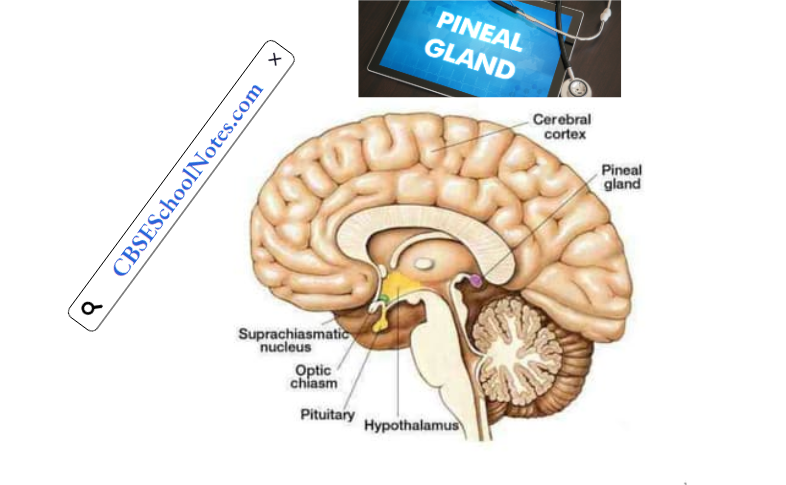Pineal Gland
The pineal gland (epiphysis cerebri) is a small endocrine gland (weighs 0.1-0.2 g). It arises as an outgrowth from the roof of the third ventricle of the brain. The gland is covered by the pia mater, which forms its capsule. Thin septa extend inward from this capsule to divide the gland into small irregular cords or lobules of cells.

The pineal gland consists of two main cell types:
- Pinealocytes and
- Interstitial cells
1. Pinealocytes:
Pinealocytes are the most numerous cell types, accounting for 95% of cells in the gland.
- These are pale-staining epithelioid cells. Their nucleus is deeply indented and cytoplasm contains both rough and smooth endoplasmic reticulum.
- The pinealocytes have a few long processes that have bulbous expansions at their terminal end. The pinealocytes secrete melatonin hormone.
2. Interstitial Cells:
These cells are far less numerous than pinealocytes (only 5%).
- They have dark staining nuclei and resemble the astrocytes of the brain in having long cell processes containing many fine filaments.
- Interstitial cells occur in proximity to pinealocytes and blood vessels.
The pineal gland also contains many mast cells, many blood vessels, and sympathetic nerve fibers. The extracellular calcified deposits of “brain sand” (corpora arenacea) are found in the pineal gland of older individuals. These concretions are found due to the deposition of calcium phosphates and carbonate on the substance secreted by pinealocytes.
Pineal gland Functions
- The functions of the pineal gland are still unclear in humans.
- The following functions can be attributed to lower animals
- Melatonin appears to have a role in light-influenced reproductive cycles.
- The release of melatonin is governed by the circadian (daily) dark-light cycle. The secretion of melatonin increases in the dark phase of the cycle.
- Melatonin suppresses the release of gonadotrophic hormones of anterior pituitary. Daylight has the reverse effect.
- The arginine vasotocin is another hormone secreted by pinealocytes. It also has antigonado-trophie activity.
- The pineal gland, in humans, also plays an important role to adjust the sudden change in daylight in persons suffering from “jet lag.”
Pineal gland Remember:
The pineal gland contains two types of cells, i.e., pinealocytes and interstitial cells. The pinealocytes secrete melatonin, while interstitial cells are like astrocytes of the brain. The pineal gland is a photosensitive organ therefore thought to respond to dark and light periods.
